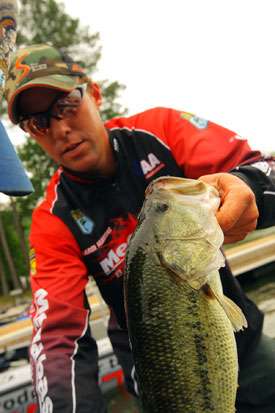
In this lesson, we're going to review some things you should know about hooks. We'll talk about general characteristics, advantages and disadvantages, and some things you'll want to think about when you select a hook. (Read it carefully. You'll need this info for next month when we go into more detail.)
OK, here goes: The first thing you need to think about is that the hook is the thing that sticks in the fish's mouth. If it comes out, the fish will get away. Sound silly? Maybe, but it's something you don't want to forget.
One important hook characteristic is wire size. According to some anglers, light wire hooks are great. I don't necessarily agree. It's true that they penetrate easily with less force. That might be helpful with light tackle finesse techniques, but that's about all.
Heavier wire hooks are harder to force into a fish's jaw but once you get them into the fish they tend to stay in better than light, or thin wire models. For some reason, it seems like fish can work the thinner wire loose easier when they shake their heads violently. Heavy wire doesn't straighten out as easily, either.
For most applications, I like a medium or heavy wire hook.
Another thing you want to think about is shank length. A long shank hook will hang lower on the lure and sometimes make it easier to hook a fish. On the other hand, a short shank will allow you to upsize without the hassle of tangled hooks on the retrieve. That also helps you hook fish.
I fish mostly with standard or short shanks.
Regardless of which model you use, you should always check the point. Do it as often as you check your line. The easiest way to do that is to hold the lure in one hand with the hooks hanging straight down. Run your thumb and first two fingers down from the lure to the hook. The points should stick easily into your skin. If they don't it's time to change them.
You can change them quickly by clipping the wire at the eye. Put the new one on with a small, titanium split ring. I don't mess around with pliers much. I let my thumb nail grow out a little bit and just use it. That's easier and faster.
Don't sharpen your hooks. You'll never get them as sharp as the factory does. Besides, most of the time a file or stone will weaken them. If the point breaks, the fish will throw the hook in no time.
I never sharpen a hook unless I'm just fun fishing.
If you're going to work with hooks, you'll also need to know and understand some hook terms:
- Point — The sharp end of the hook that goes into the fish.
- Barb — The spike that sticks out near the point, on the inside of the wire.
- Bend — The wire part that circles around from the point to the shank.
- Shank — The wire from the bend to the eye.
- Gap — The distance from the point to the shank.
- Eye — The closed loop at the top of the shank.
One final thought: Hook sizes and designs are not standardized. A wide gap hook from one maker doesn't necessarily match up with that of another. The same thing is true for sizes and designs. Keep it in mind.
That's enough for now. Next time we'll talk about which hooks should be used with which classes of artificial lures and why. I'll also give you my opinion about which specific hooks work best with some of the more popular baits.





